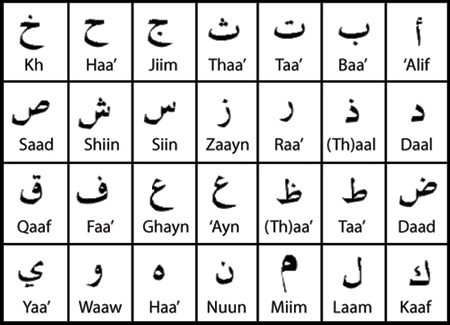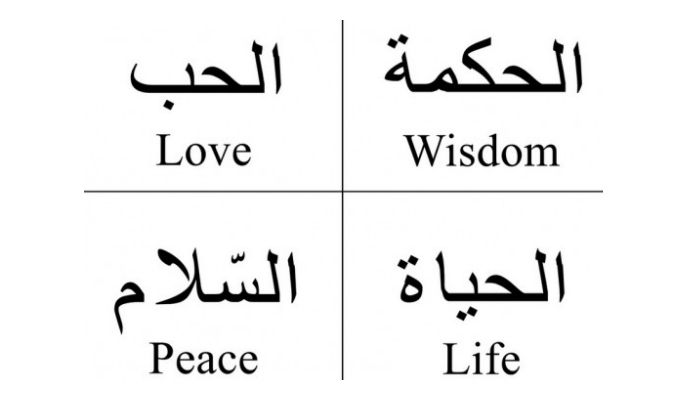Is Arabic a Hard Language?
Is Arabic a Hard Language?
A blog post by BASE Arabic instructor Danyal
Many people have asked me this question: Is Arabic a hard language to learn? Certainly the relative difficulty of any language depends on a variety of factors, some of which are inherent to the language itself and others that relate to how similar or different it is with the student’s native language. Let us take a brief look at the difficulties Arabic poses to the native English speaker, as well as some of its challenges that may not be quite as difficult as we imagine.
The Writing System

Perhaps the most visible challenge to learning Arabic is the writing system. If one is only familiar with languages that use the Roman alphabet, the curly connecting Arabic script may seem daunting. But be not deceived- the Arabic script, as far as writing systems go, is not extraordinarily hard. It consists of twenty-eight letters that represent consonant and long vowel sounds, and each of these letters represents a single, consistent sound. Certainly easier than the writing systems of Chinese and Japanese, which have thousands of characters that represent words, not sounds. In fact, Arabic may be easier than English or French in this respect- both of the latter use one letter to represent multiple sounds, or multiple letters to represent the same sounds, as well as having numerous silent letters.
The fact still remains that the Arabic letters connect to each other, and their shapes change based on whether they are joined to another letter on the left, on the right, or on both sides- some letters taking on as many as four different shapes. The good news is that even though the letters change shape when they connect, usually the change is rather simple- part of the letter is removed to allow it to join hands with its neighbor, so the changes are not just random or arbitrary. Add to this that Arabic doesn’t have capital and lowercase letters, and I would say that the Arabic alphabet is more or less equal in difficulty to the Roman alphabet. A typical college Arabic curriculum finishes the alphabet within a semester, but a motivated student with enough time on their hands could learn it through self study within a month or even less.
Pronunciation

Okay- so much for the alphabet, what about speaking the language? Here we are dealing with a completely different beast. Let’s look at pronunciation first. When it comes to vowels, Arabic is rather simple. Almost all Arabic vowel sounds are roughly equivalent to sounds we have in English, and in general Arabic has fewer of them. It’s in the consonant department where Arabic goes a little crazy. Arabic has a lot more “throaty” sounds then we use commonly in English. The letter “khaa” is pronounced like the ch in chutzpah or loch. There are two different “h” sounds, a normal one, and a more forceful, breathy aspiration, like the breath you exhale when trying to fog up your glasses. There is also the letter “hamza”, which is what in linguistics as known as a glottal stop. It is the sound that replaces the “t” in “butter” and “bottle” in some British accents. And the list goes on. Still, I contend that pronunciation does not make Arabic an exceptionally hard language. Most foreign languages that are commonly studies by English speakers (French, Spanish, Italian, German, etc.) have phonetics that are quite different from that of English. This is a challenge present in learning any foreign language, and it certainly pays off to pay attention to mastering the sounds early on in the language learning process. On the other hand, it is quite possible to become quite fluent in a language even if your pronunciation isn’t perfect- as long as you are understandable enough for clear communication.
Words, words, words….

Now let’s look at words. Immediately we are struck by the absence of cognates. Most European languages draw heavily on the heritage of Greek and Latin- these include common everyday words like school and student, but become even more common as we get into the higher register, more academic language. Arabic too has been influenced by Greek and Latin, but to a much lesser extent, and for most of these common cognates across European languages, Arabic has a totally different word, derived from an Arabic root. Certainly, this lack of cognates can make it a bit harder to remember vocabulary at the beginning- but once the student gets to an intermediate level and beyond, Arabic begins to reveal its true beauty, which lies in the simple elegance of its root system.
In a nutshell, most Arabic words are formed by a three letter root. By adding affixes and playing around with the vowel structure between the three letters, one can derive numerous words with related meanings. For example, the Arabic word for a lesson is “dars”. Its root is D-R-S. From this same route we have the words “madrasa” (school), “mudarris” (teacher), and “diraasa” (study). The root system provers a powerful tool for learning new vocabulary where cognates to English fail.
A final note on words- I have heard some Arabic speakers claim that Arabic has more words than any other language, and given figures of many millions. Such claims, to the extent of my knowledge, have little basis in fact. I am sure if we were to take the sum total of all words in an Arabic and an English dictionary, English would have more if only because of all the specialized terminology for every branch of modern science. The more interesting question is, which language has more words that are commonly used and understood by native speakers? I will not attempt to answer this now; it may require an article of its own.
Syntax
Moving on to the syntax of Arabic, we find that the Arabic verb has various conjugations based on who is doing the action, not unlike what we see in Spanish and many other romance languages. Classical Arabic also had case endings for nouns, similar to the declensions in Latin, German, or Slavic languages, but these are not used in contemporary spoken Arabic at all, so we can disregard them when considering the difficulty of Arabic.
But where Arabic really seems like an easy language is its verb tenses. It basically has two- present and past. The future is expressed by adding a prefix onto the present tense. There really is no equivalent to the present perfect and past perfect that we use so often in English. In Arabic if I want to say “have you eaten?” I would just say: “Did you eat, or not yet?”
Where the Difficulty Actually Lies
We can see that the writing system, pronunciation, and vocabulary of Arabic are no piece of cake, but neither is there anything there that makes the language especially hard. The syntax is more complex than English in some respects, but much simpler in others. So far I would give Arabic a difficulty rating of average. But there is one more feature of the language that we have yet to touch upon- a linguistic condition known as diglossia.
Diglossia is when a language has split into two different registers- in other words the language that people speak on a day to day basis is not quite the same as the literary language that is taught in school. In Arabic, the formal register is called fusHa, and it includes the classical Arabic of the Quran and early poetry, as well as the Modern Standard Arabic used in news broadcasts and most contemporary literature. While fusHa is held in great reverence, it is rarely used in conversation, except ironically. In fact, for many Arabic speakers it is something like a second language, which they understand and speak to some extent, but often with some difficulty. Thus, a student who only learns fusHa will have limited ability to have natural conversations with Arabic speakers.
To complicate matters further, the colloquial register of Arabic, the kind that is actually used in most situations, varies tremendously across countries and regions. While the various dialects have more in common with each other than they do with fusHa, they still have significant differences, especially with some of the most common words. Almost every region has a unique word to mean “now”. The following table illustrates these differences.

The question often arises- can Arabic speakers from different countries understand each other? The answer is yes and no. The dialects are not mutually intelligible by nature, but they are similar enough that with sufficient exposure to another dialect, they can be. In the age of globalization, this cross-regional exposure is more and more common, so nowadays most people from around the Arabic-speaking world can communicate with each other easily. Oftentimes, people who speak less well-known dialects will adjust their speech to match a more well-known dialect such as Egyptian or Syrian.
What does that mean for the student of Arabic? It means that Arabic is awesome. It means that learning to have basic communication in one dialect is a very attainable and rewarding goal for a beginner, and for the bold few that plunge into the depths of Arabic, there will always be more to master. If you want to be a good Arabic “generalist”, the best thing to do is have a lot of interaction with native speakers from all over. Use whatever you’ve learned in whatever dialect with your Arabic-speaking friends, or the guy at the gas station, or at the middle eastern store. They might teach you another word for something from their dialect, and you will start to notice the patterns that allow you to transfer knowledge of one dialect and apply it to another.